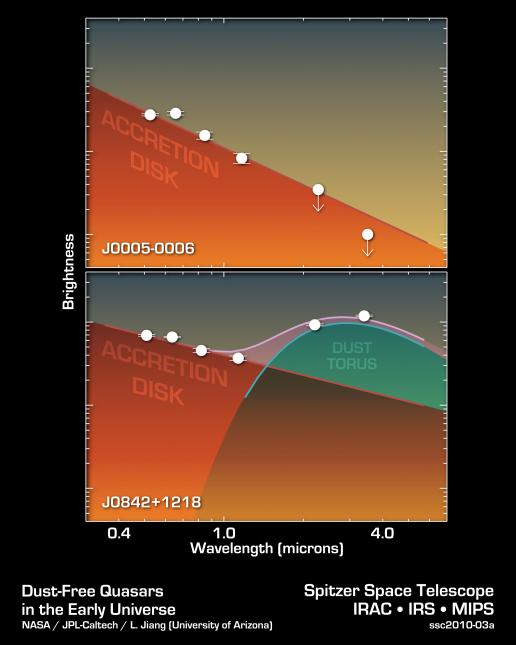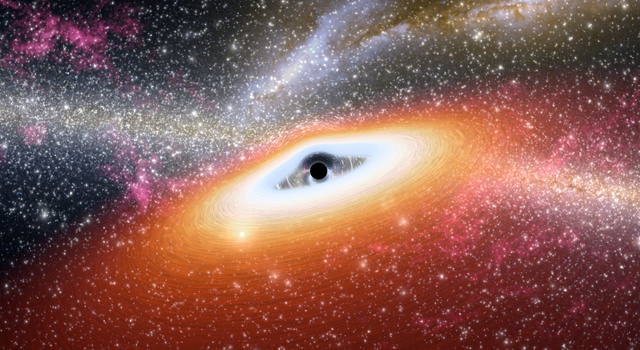[/caption]
The Spitzer Space Telescope has found what appear to be two of the earliest and most primitive supermassive black holes known. “We have found what are likely first-generation quasars, born in a dust-free medium and at the earliest stages of evolution,” said Linhua Jiang of the University of Arizona, Tucson, lead author of a paper published this week in Nature.
A quasar is a compact region in the center of a massive galaxy surrounding the central supermassive black hole.
As shown by the image we posted earlier today from the Planck mission, our galaxy – and the Universe – is littered with dust. But scientists believe the very early universe didn’t have any dust — which tells them that the most primitive quasars should also be dust-free. But nobody had seen any “clean” quasars — until now.
Spitzer has identified two — the smallest on record — about 13 billion light-years away from Earth. The quasars, called J0005-0006 and J0303-0019, were first unveiled in visible light using data from the Sloan Digital Sky Survey. That discovery team, which included Jiang, was led by Xiaohui Fan, a coauthor of the recent paper. NASA’s Chandra X-ray Observatory had also observed X-rays from one of the objects. X-rays, ultraviolet and optical light stream out from quasars as the gas surrounding them is swallowed.
“Quasars emit an enormous amount of light, making them detectable literally at the edge of the observable universe,” said Fan.

When Jiang and his colleagues set out to observe J0005-0006 and J0303-0019 with Spitzer between 2006 and 2009, their targets didn’t stand out much from the usual quasar bunch. Spitzer measured infrared light from the objects along with 19 others, all belonging to a class of the most distant quasars known. Each quasar is anchored by a supermassive black hole weighing more than 100 million suns.
Of the 21 quasars, J0005-0006 and J0303-0019 lacked characteristic signatures of hot dust, the Spitzer data showed. Spitzer’s infrared sight makes the space telescope ideally suited to detect the warm glow of dust that has been heated by feeding black holes.
“We think these early black holes are forming around the time when the dust was first forming in the universe, less than one billion years after the Big Bang,” said Fan. “The primordial universe did not contain any molecules that could coagulate to form dust. The elements necessary for this process were produced and pumped into the universe later by stars.”
The astronomers also observed that the amount of hot dust in a quasar goes up with the mass of its black hole. As a black hole grows, dust has more time to materialize around it. The black holes at the cores of J0005-0006 and J0303-0019 have the smallest measured masses known in the early universe, indicating they are particularly young, and at a stage when dust has not yet formed around them.
The Spitzer observations were made before the telescope ran out of its liquid coolant in May 2009, beginning its “warm” mission.
Source: JPL


Interesting.
I was looking at the image above and It remined me that there are many interpretations of the “look” of a black hole.
What would a black hole actually look like if viewed by humans?
From my understanding, material would be infinitely red-shifted at the horizon due to it’s struggle against the hole’s gravity. If we assume the hole is gobbling gas, then this gas would be superheated, form roughly into a plane, and glow?
So if a viewer were stationed at a safe distance from the hole and above the plane, what would they see if they looked directly at the hole?
Just curious as I’ve seen many interpretations… and as we all know from wormhole interpretations, often they are wrong.
These quasars may make excellent probes of intergalactic absorption clouds between the quasar and Earth since absorption line complexes associated with the quasar should be either absent or extremely weak.
@Uncle Fred,
Check out the numerous animations and graphics at “Journey Into A Schwarzschild Black Hole” here: http://jila.colorado.edu/~ajsh/insidebh/schw.html . Pure digital delight! 🙂
The material observed here is not that close to the event horizon. A 10^8 solar mass black hole has a Schwarzschild radius around the radius of Earth’s orbit around the sun. The observations here occur at a distance of ~ 100-1000 Schwarzschild radii. The redshifting of light from sources observed there is z ~ 10^{-2} -10^{-4}, which is not that extensive.
LC
@Jon Hanford;
What a great resource. Excellent for the visual learners. Thanks.
@Uncle Fred
Don’t know if this one is in there http://www.newscientist.com/article/dn16885-what-would-it-look-like-to-fall-into-a-black-hole.html
The idea of a pre-dust universe fascinates me. It’s so obvious and simple really, but with all dust rings we’re accustomed to seeing throughout galaxies it’s strange/wild to ponder a real dividing line between the way the early universe was and now.
A ‘colossol event’ that leads to the creation of the universe seems even less deniable to me now. We people weren’t even possibilities for such a long time. Gravity is so slow and unimpressive when I easily raise my hand, but over time it can consume the very galaxies it helps create. Brain candy.
A preprint of “Dust-free quasars in the early universe” by Jhang et al has been posted: http://arxiv.org/abs/1003.3432
Weighing in at 100 million solar masses, these SMBHs make our galaxy’s 6 million solar mass black hole seem relatively puny. I’ve sometimes wondered, what is the plausible upper mass for either a stationary or rotating black hole?